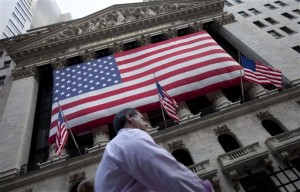US stocks rise on data, dovish ECB meeting

In this Monday, Aug. 8, 2011, file photo, a man walks past the New York Stock Exchange in New York. Wall Street stocks rose Wednesday following a wave of mostly solid US data and a fresh confirmation of ultra-easy money policies by the European Central Bank. AP PHOTO/JIN LEE
NEW YORK–Wall Street stocks rose Wednesday following a wave of mostly solid US data and a fresh confirmation of ultra-easy money policies by the European Central Bank.
The Dow Jones Industrial Average advanced 64.33 points (0.36 percent) to 18,076.27.
The broad-based S&P 500 added 4.47 (0.21 percent) at 2,114.07, while the tech-rich Nasdaq Composite Index gained 22.71 (0.45 percent) to 5,099.23.
Economic reports showed a big drop in the US trade deficit in April, slower growth in the US services sector in May and a solid 201,000 new private-sector jobs in May.
The Federal Reserve’s Beige Book reported that the US economy returned to modest-to-moderate growth during April and May after stalling in the first quarter of the year.
ECB President Mario Draghi praised the bank’s stimulus policies and said there were no plans to end them more quickly than planned.
“As long as you have a central bank providing monetary support, that’s going to be a positive sign for investment in equity markets, be it European or US,” said Michael James, managing director of equity trading at Wedbush Securities.
James attributed the rise in retail stocks to Tuesday’s US auto sales report, which showed stronger than expected and suggested stronger consumer spending ahead.
Best Buy rose 0.9 percent, Dow member Home Depot added 1.4 percent and Target and Williams-Sonoma both gained 0.4 percent.
But petroleum stocks fell on a pullback in oil prices. Anadarko Petroleum fell 1.0 percent, Chesapeake Energy lost 3.5 percent and Occidental Petroleum dropped 1.4 percent.
Dow member AT&T jumped 2 percent following a report from Jefferies that praised its plans to acquire DirecTV.
Frontier Communications rose 4.3 percent following an upgrade from DA Davidson.
Bond prices fell. The yield on the 10-year US Treasury rose to 2.37 percent from 2.26 percent Tuesday, while the 30-year advanced to 3.10 percent from 3.02 percent. Bond prices and yields move inversely.